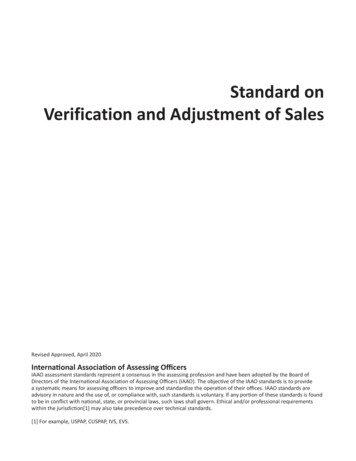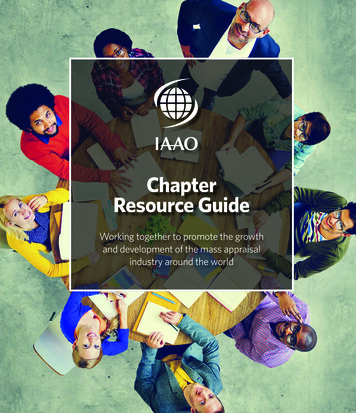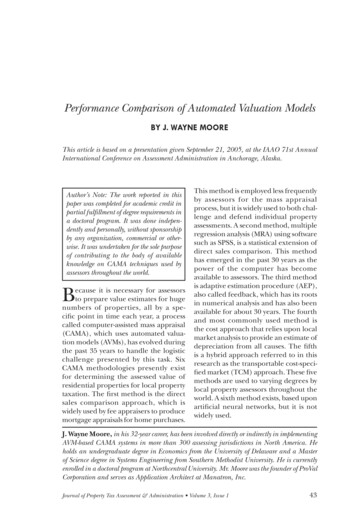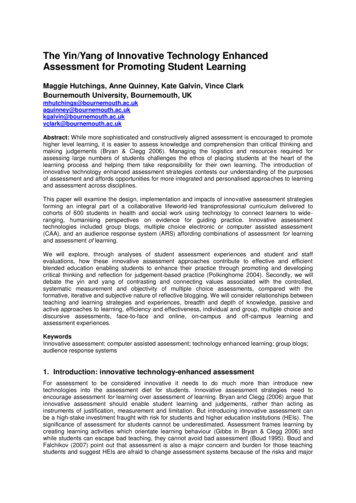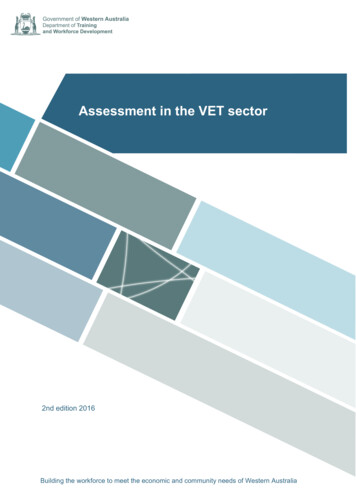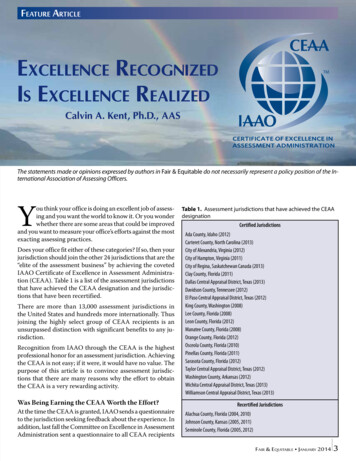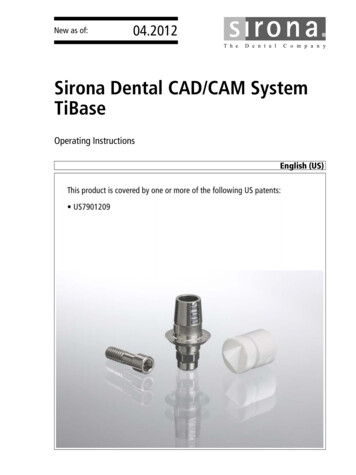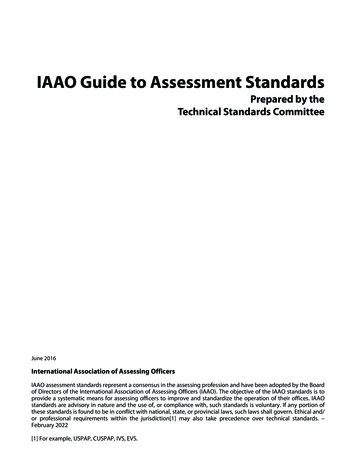
Transcription
IAAO Guide to Assessment StandardsPrepared by theTechnical Standards CommitteeJune 2016International Association of Assessing OfficersIAAO assessment standards represent a consensus in the assessing profession and have been adopted by the Boardof Directors of the International Association of Assessing Officers (IAAO). The objective of the IAAO standards is toprovide a systematic means for assessing officers to improve and standardize the operation of their offices. IAAOstandards are advisory in nature and the use of, or compliance with, such standards is voluntary. If any portion ofthese standards is found to be in conflict with national, state, or provincial laws, such laws shall govern. Ethical and/or professional requirements within the jurisdiction[1] may also take precedence over technical standards. –February 2022[1] For example, USPAP, CUSPAP, IVS, EVS.
AcknowledgmentsAt the time of the the 2016 revision update to the Guide to Assessment Standards theTechnical Standards Subcommittee was composed of Alan Dornfest, AAS, SubcommitteeChair, Josh Myers, Carol Neihardt, associate member Wayne Forde, August Dettbarn,Bill Marchand, and Chris Bennett, staff liaison. The chair of the Research and StandardsCommittee was Doug Warr.Published byInternational Association of Assessing Officers314 W 10th StKansas City, Missouri 64105-1616816/701-8100fax: 816/701-8149http://www.iaao.orgISBN 978-0-88329-222-8Copyright 2016 by the International Association of Assessing OfficersAll rights reserved.No part of this publication may be reproduced in any form, in an electronic retrieval system or otherwise, withoutthe prior written permission of the publisher. However, assessors wishing to use this standard for educating legislators and policymakers may photocopy it for limited distribution.Printed in the United States of America
ContentsIAAO GUIDE TO ASSESSMENT STANDARDS—20161. Scope.72. Legal Framework.72.1 Legal Basis for Assessment.2.1.1 Statutory Authority.72.1.2 Regulations in Support of Legislation.72.1.3 Legal Level of Value and Assessment.72.2 Reassessment and Reappraisal Cycle.72.3 Property Tax Base.72.3.1 Role of the Property Tax.72.3.2 State and Provincial Responsibilities.72.3.3 Local Government Responsibilities.72.3.4 National Government Involvement.72.3.5 Classification.72.3.6 Exemptions.72.3.7 Circuit Breakers.72.3.8 Limits on Changes in Assessments.72.3.9 Abatements and Tax Increment Financing.72.3.10 Assessment Roll Approval.72.4 Taxation.72.4.1 Tax Levies and Rates.72.4.2 Limits.72.4.3 Rollbacks.72.4.4 Truth in Taxation.72.4.5 Assessment Roll—Legal Issues.72.4.5.1 Appeals on Total Value.72.4.5.2 Public Access.73. Administrative Considerations.73.1 Organizational Framework.73.2 Resources.73.2.1 Funding.73.2.2 Staffing and Personnel Qualifications.73.2.3 Computer Support.83.2.4 Office Facilities and Equipment.83.2.5 Office Supplies and Forms.83.2.6 Reference Materials and Data.83.2.7 Vehicles.83.3 Training, Education, and Certification.83.3.1 Training and Education.83.3.2 Certification of Assessment Personnel.83.4 Legislation and Regulations.83.5 Progress and Production Reporting.83.6 Security.84. Property Data Requirements.84.1 Deeds and Ownership Transfers.84.2 Property Identification and Description.84.2.1 Cadastral Maps, Parcel Identification, and Geographic Information Systems.84.2.2 Property Characteristics, Data Collection, and Data Entry.8
Contents4.2.3 Sales Data, Screening, Processing, and Adjustment.84.2.4 Income and Expense Data.84.2.5 Building and Construction Costs.84.2.6 Data Management.85. Real Property Appraisal.85.1 Collecting and Maintaining Property Data.85.2 Frequency of Reappraisal.85.3 Mass Appraisal and Automated Valuation Models.85.4 Cost Approach.85.4.1 Estimating Land Value.85.4.2 Estimating Current Construction Costs.85.4.3 Depreciation.85.5 Sales Comparison Approach.95.5.1 Sale Price Adjustments.95.5.2 Market Analysis and Stratification.95.6 Income Approach.95.6.1 Capitalization Techniques.95.6.2 Discount, Interest, and Equity Yield Rates.95.7 Land Valuation.95.7.1 Land Data Requirements.95.7.2 Units of Comparison.95.7.3 Land Valuation Methods.95.8 Considerations by Property Type.95.8.1 Single-Family Residential.95.8.2 Multifamily Residential.95.8.3 Manufactured Property.95.8.4 Commercial.95.8.5 Industrial.95.8.6 Nonagricultural.95.8.7 Agricultural Land.95.8.8 Special Purpose Property.95.8.9 Environmentally Contaminated Property.95.9 Value Reconciliation.96. Personal Property Appraisal.96.1 Definition.96.2 Discovery and Reporting of Taxable Property.96.2.1 Returns.96.2.2 Audits.96.3 Valuation.96.3.1 Trade Levels.96.3.2 Approaches.96.3.3 Tangible.96.3.4 Intangible.96.4 Evaluating Performance.97. Assessment Tools. 107.1 Standard Forms. 107.2 Manuals, Handbooks, and Guidelines. 107.3 Software and Hardware for Computer-Assisted Mass Appraisal and AssessmentSystems. 10
Contents7.4 Office Supplies and Equipment. 108. Managerial Procedures and Internal Controls. 108.1 Organization and Staffing. 108.1.1 Analyzing Jobs and Work. 108.1.2 Job Specifications. 108.2 Orientation, Training, and Development. 108.2.1 Determining Training Needs. 108.2.2 Training Methods. 108.2.3 Evaluation of Training. 108.2.4 Continuing Education. 108.2.5 Career Planning. 108.2.6 Professional Membership, Certification, and Designation. 108.3 Assessment Accuracy Requirements. 108.4 Technical and Professional Services. 108.4.1 Request for Proposal (RFP). 108.4.2 Awarding of Contracts. 108.4.3 Monitoring Contract Performance. 108.4.4 Considerations by Type of Service. 108.5 Equalization. 108.5.1 Direct Equalization. 108.5.2 Indirect Equalization. 109. Valuation Review and Appeal Process. 109.1 Valuation Review. 109.1.1 Ratio Studies. 109.1.2 Procedural/Performance Audits-Reviews. 109.2 Assessment Appeal. 109.3 Structure of the Recommended Appeal System. 109.3.1 Locally Assessed Property. 109.3.2 Centrally Assessed Property. 109.4 Qualifications/Training of Appeal Board and Tribunal Officials. 109.5 Notification of Appeals Process. 119.6 Notice of Assessment. 119.7 The Appeal Hearing. 1110. Public Information, Communications, Relations. 1110.1 Developing a Public Relations Program. 1110.2 Developing a Procedural Manual. 1110.3 Public Records. 1110.4 Communication Channels. 1110.4.1 Printed Information and Correspondence. 1110.4.2 Media Contacts. 1110.4.3 Speaking Engagements. 1110.4.4 Internet Web Sites. 1110.5 Contacts with other Public Officials. 1110.6 Appeals Process. 1110.7 Public Education. 11References. 11Suggested Reading. 11
IAAO GUIDE TO ASSESSMENT STANDARDS—2016IAAO Guide to Assessment Standards1. ScopeThis document is intended to serve as a subject indexto IAAO standards that provide guidelines with respectto assessment administration. In addition to referencingstandards, many of the items are discussed in detail inIAAO textbooks.For additional guidance refer to state, provincial, andnational statutes, constitutional provisions, regulationsand case law.2. Legal Framework2.1 Legal Basis for AssessmentStandard on Property Tax Policy2.1.1 Statutory AuthorityStandard on Oversight Agency ResponsibilitiesStandard on Property Tax Policy2.1.2 Regulations in Support of LegislationStandard on Oversight Agency ResponsibilitiesStandard on Property Tax Policy2.1.3 Legal Level of Value and AssessmentStandard on Property Tax Policy2.2 Reassessment and Reappraisal CycleStandard on Mass Appraisal of Real PropertyStandard on Property Tax PolicyStandard on Ratio StudiesStandard on Verification and Adjustment of Sales2.3 Property Tax Base2.3.1 Role of the Property TaxStandard on Property Tax Policy2.3.2 State and Provincial ResponsibilitiesStandard on Oversight Agency ResponsibilitiesStandard on Property Tax Policy2.3.3 Local Government ResponsibilitiesStandard on Property Tax Policy2.3.4 National Government InvolvementStandard on Property Tax PolicyStandard on the Valuation of Properties Affected byEnvironmental Contamination2.3.5 ClassificationStandard on Property Tax Policy2.3.6 ExemptionsStandard on Property Tax Policy2.3.7 Circuit BreakersStandard on Property Tax Policy2.3.8 Limits on Changes in AssessmentsStandard on Property Tax Policy2.3.9 Abatements and Tax Increment FinancingStandard on Property Tax Policy2.3.10 Assessment Roll ApprovalStandard on Oversight Agency ResponsibilitiesStandard on Property Tax Policy2.4 Taxation2.4.1 Tax Levies and RatesStandard on Property Tax Policy2.4.2 LimitsStandard on Property Tax Policy2.4.3 RollbacksStandard on Property Tax Policy2.4.4 Truth in TaxationStandard on Property Tax Policy2.4.5 Assessment Roll—Legal IssuesStandard on Assessment AppealStandard on Property Tax Policy2.4.5.1 Appeals on Total ValueStandard on Assessment Appeal2.4.5.2 Public AccessStandard on Assessment AppealStandard on Public Relations3. Administrative Considerations3.1 Organizational FrameworkStandard on Oversight Agency ResponsibilitiesStandard on Property Tax Policy3.2 ResourcesStandard on Digital Cadastral Maps and Parcel IdentifiersStandard on Manual Cadastral Maps and ParcelIdentifiersStandard on Mass Appraisal of Real PropertyStandard on Oversight Agency ResponsibilitiesStandard on Property Tax PolicyStandard on Ratio StudiesStandard on Valuation of Personal Property3.2.1 FundingStandard on Mass Appraisal of Real PropertyStandard on Oversight Agency Responsibilities3.2.2 Staffing and Personnel QualificationsStandard on Contracting for Assessment ServicesStandard on Digital Cadastral Maps and ParcelIdentifiersStandard on Manual Cadastral Maps and ParcelIdentifiersStandard on Mass Appraisal of Real PropertyStandard on Oversight Agency ResponsibilitiesStandard on Professional Development7
IAAO GUIDE TO ASSESSMENT STANDARDS—20163.2.3 Computer SupportStandard on Contracting for Assessment ServicesStandard on Mass Appraisal of Real PropertyStandard on Oversight Agency Responsibilities3.2.4 Office Facilities and EquipmentStandard on Digital Cadastral Maps and ParcelIdentifiersStandard on Manual Cadastral Maps and ParcelIdentifiers3.2.5 Office Supplies and FormsStandard on Oversight Agency Responsibilities3.3 Training, Education, and Certification3.3.1 Training and EducationStandard on Contracting for Assessment ServicesStandard on Digital Cadastral Maps and ParcelIdentifiersStandard on Oversight Agency ResponsibilitiesStandard on Professional DevelopmentStandard on Ratio Studies3.3.2 Certification of Assessment PersonnelStandard on Contracting for Assessment ServiceStandard on Oversight Agency ResponsibilitiesStandard on Professional Development3.4 Legislation and RegulationsStandard on Oversight Agency ResponsibilitiesStandard on Property Tax Policy3.5 Progress and Production ReportingStandard on Contracting for Assessment ServicesStandard on Mass Appraisal of Real PropertyStandard on Oversight Agency ResponsibilitiesStandard on Verification and Adjustment of Sales3.6 SecurityStandard on Digital Cadastral Maps and ParcelIdentifiersStandard on Manual Cadastral Maps and ParcelIdentifiersStandard on Mass Appraisal of Real Property4. Property Data Requirements4.1 Deeds and Ownership TransfersStandard on Automated Valuation Models (AVMs)Standard on Digital Cadastral Maps and ParcelIdentifiersStandard on Manual Cadastral Maps and ParcelIdentifiersStandard on Ratio StudiesStandard on Verification and Adjustment of Sales4.2 Property Identification and DescriptionStandard on Automated Valuation Models (AVMs)Standard on Contracting for Assessment ServicesStandard on Digital Cadastral Maps and ParcelIdentifiersStandard on Manual Cadastral Maps and ParcelIdentifiersStandard on Verification and Adjustment of Sales84.2.1 Cadastral Maps, Parcel Identification, andGeographic Information SystemsStandard on Automated Valuation ModelsStandard on Digital Cadastral Maps and ParcelIdentifiersStandard on Manual Cadastral Maps and ParcelIdentifiers4.2.2 Property Characteristics, Data Collection,and Data EntryStandard on Assessment AppealStandard on Automated Valuation Models (AVMs)Standard on Contracting for Assessment ServicesStandard on Mass Appraisal of Real PropertyStandard on Ratio StudiesStandard on Verification and Adjustment of Sales4.2.3 Sales Data, Screening, Processing, andAdjustmentStandard on Automated Valuation Models (AVMs)Standard on Mass Appraisal of Real PropertyStandard on Ratio StudiesStandard on Valuation of Personal PropertyStandard on Verification and Adjustment of Sales4.2.4 Income and Expense DataStandard on Mass Appraisal of Real Property4.2.5 Building and Construction CostsStandard on Mass Appraisal of Real Property4.2.6 Data ManagementStandard on Automated Valuation Models (AVMs)Standard on Mass Appraisal of Real Property5. Real Property Appraisal5.1 Collecting and Maintaining Property DataStandard on Mass Appraisal of Real Property5.2 Frequency of ReappraisalStandard on Mass Appraisal of Real Property5.3 Mass Appraisal and Automated Valuation ModelsStandard on Automated Valuation Models (AVMs)Standard on Mass Appraisal of Real Property5.4 Cost ApproachStandard on Automated Valuation Models (AVMs)Standard on Mass Appraisal of Real PropertyStandard on the Valuation of Property Affected byEnvironmental Contamination5.4.1 Estimating Land ValueStandard on Automated Valuation Models (AVMs)Standard on Mass Appraisal of Real Property5.4.2 Estimating Current Construction CostsStandard on Mass Appraisal of Real PropertyStandard on the Valuation of Property Affected byEnvironmental Contamination5.4.3 DepreciationStandard on Automated Valuation Models (AVMs)Standard on Mass Appraisal of Real PropertyStandard on the Valuation of Property Affected byEnvironmental Contamination
IAAO GUIDE TO ASSESSMENT STANDARDS—20165.5 Sales Comparison ApproachStandard on Automated Valuation Models (AVMs)Standard on Mass Appraisal of Real PropertyStandard on Verification and Adjustment of Sales5.5.1 Sale Price AdjustmentsStandard on Automated Valuation Models (AVMs)Standard on Ratio StudiesStandard on Verification and Adjustment of Sales5.5.2 Market Analysis and StratificationStandard on Automated Valuation Models (AVMs)Standard on Mass Appraisal of Real PropertyStandard on Ratio StudiesStandard on Verification and Adjustment of Sales5.6 Income ApproachStandard on Automated Valuation Models (AVMs)Standard on Mass Appraisal of Real PropertyStandard on the Valuation of Property Affected byEnvironmental ContaminationStandard on Verification and Adjustment of Sales5.6.1 Capitalization TechniquesStandard on Automated Valuation Models (AVMs)Standard on Mass Appraisal of Real PropertyStandard on Verification and Adjustment of Sales5.6.2 Discount, Interest, and Equity Yield RatesStandard on Automated Valuation Models (AVMs)Standard on Mass Appraisal of Real Property5.7 Land ValuationStandard on Automated Valuation Models (AVMs)Standard on Mass Appraisal of Real PropertyStandard on Verification and Adjustment of Sales5.7.1 Land Data RequirementsStandard on Digital Cadastral Maps and ParcelIdentifiersStandard on Manual Cadastral Maps and ParcelIdentifiersStandard on
Standard on Property Tax Policy. 2.1.3 Legal Level of Value and Assessment. Standard on Property Tax Policy. 2.2 Reassessment and Reappraisal Cycle. Standard on Mass Appraisal of Real Property Standard on Property Tax Policy Standard on Ratio Studies Standard on Verification and Adjustment of Sales. 2.3 Property Tax Base 2.3.1 Role of the .
